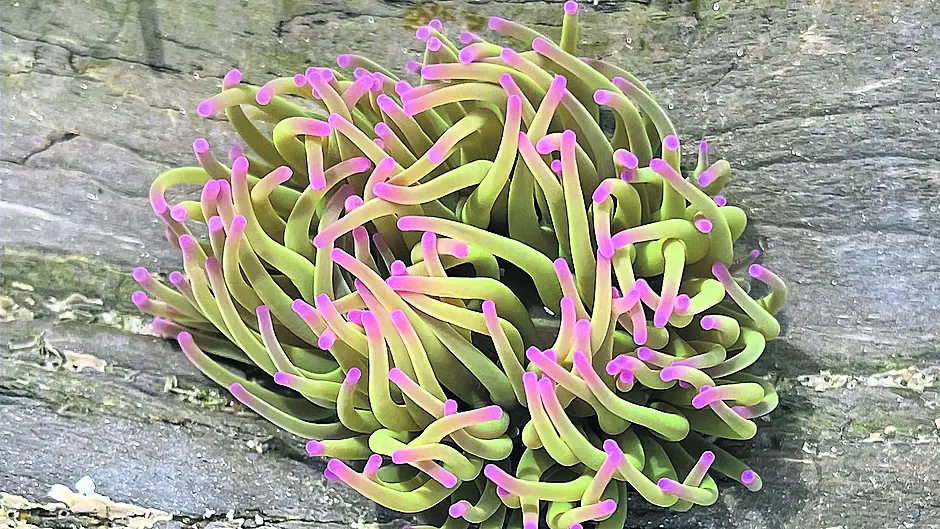BY ANN HAIGH
IF you love marine wildlife and adventure, you might be familiar with dreaming about diving on the Great Barrier Reef, snorkelling in the Red Sea or cruising around the Galapagos Islands. Indeed, these are just dreams for me at the moment but fortunately there is plenty to satisfy a passion for marine life right here in West Cork.
All you need to do is put on your wellies, head to the coast and find some rockpools to gaze into to observe some truly ‘exotic’ creatures. It’s best to check the tides online and visit the beach at low tide, when the sea has retreated and salty pools full of colour and intrigue are revealed. No airplane tickets are required and trust me, this is an activity for all ages. The sense of wonder and discovery brings an exhilaration that is hard to beat.
Sea anemones
One of the most beguiling creatures you will see in and around rockpools are sea anemones and they definitely tick the box on the ‘exotic’ front. With names such as Gem, Daisy, Strawberry and Dahlia Anemone you can expect to see something beautiful and they don’t disappoint. I have seen all four of these species locally on our shores, but Beadlet and Snakelocks Anemones are more common.
While these don’t have such dainty names, they are just as spectacular. You may find anemones underwater or exposed at low tide. They are at their most flamboyant while underwater, with their mesmerising tentacles waving.
Out of water they appear jelly-like, with Beadlet Anemones looking like dark red, brown or green jelly blobs adhering to the rocks. Sea anemones are actually related to jellyfish, both animals being in the Cnidarian group. Indeed, don’t be fooled by their elegance, they are actually efficient predators and have stinging cells on those tentacles which they use to stun and entrap prey such as small crustaceans, molluscs and fish before drawing them into their body through their mouth opening (which is also their anus) and digesting them.
Fortunately, in Ireland we don’t have sea anemones with stinging cells capable of piercing human skin, so while some individuals may have a sensitivity to them, serious issues are rare.
Molluscs
Marine molluscs include sea snails and slugs, and some that you may observe locally in the intertidal area are Limpets, Whelks, Topshells, Periwinkles and Mussels, to mention a few.
One species to watch out for is the Dogwhelk. Dogwhelks are impressive carnivores that can mount limpets, barnacles and mussels and bore small holes in their shells with their drill-like spiny ‘tongue’, known as a radula.
They then inject paralysing toxins and digestive enzymes into their victims and suck up their meal through the small hole with their straw-like proboscis. Just perfect for Hallowe’en. Keep an eye out on the beach for empty limpet or mussel shells with tiny holes in them, you can now tell your friends how these creatures met their end.
Crustaceans
Common Prawns, Rockpool Shrimp, Crabs and Barnacles are among the crustaceans you may be lucky enough to spot.
Crabs are always a fun find but do add an element of danger, watch your fingers! You’re most likely to find the Common Shore Crab which is usually a greenish colour and can come in a variety of sizes, up to 8cm across, as they mature and grow.
I have frequently seen Hermit Crabs locally, so keep your eyes peeled. They are fascinating to observe as they move about with their repurposed homes on their backs.
Most frequently they use the empty shells of periwinkles or whelks as their new shelter. It’s a lesson to us to see repurposing and upcycling in full action in the natural world, sustainable housing at its best!
Fish
The fish you may see in rockpools are quite unique because they have adapted for a life where they are underwater at high tide and trapped in rockpools at low tide.
Blennies, Rocklings and Gobies are among those you may see.
My most common find is the Shanny, also known as the Common Blenny, which is notable in that it can move and survive out of water for extended periods, giving it the nickname ‘sea-frog’.
As you explore the shore you can look under rocks and turn over seaweed, but always remember to be careful on slippery rocks, return everything back to where you found it and do not remove anything from the rocks or the beach (apart from litter).
If you do pick up or touch any of the creatures, be careful not to harm them and be mindful that many can’t survive out of water, sea urchins and starfish for example.
Remember if you’re at a loose end and yearning for a fix of the exotic, don’t forget what you can see on the West Cork coast. Wild Atlantic all the way!
• Ann Haigh MVB MSc MRCVS is a Skibbereen resident, a mum-of-two and a veterinarian with a masters in wildlife health and conservation and she is passionate about biodiversity and nature.










